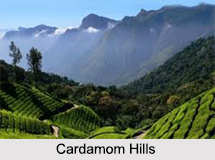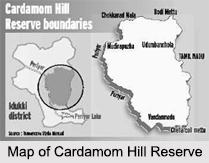 Cardamom hills are a part of the south Western Ghats nestled in the southeast of Kerala and southeast of Tamil Nadu. Anai Mudi is the highest peak in the Cardamom hills. The Cardamom hills are home to tribes like Mudugan, Urumban and Irulan who work in the tea gardens to earn their livelihood. In addition to tea, the hills are known for producing coffee, teak, bamboo and cardamom.
Cardamom hills are a part of the south Western Ghats nestled in the southeast of Kerala and southeast of Tamil Nadu. Anai Mudi is the highest peak in the Cardamom hills. The Cardamom hills are home to tribes like Mudugan, Urumban and Irulan who work in the tea gardens to earn their livelihood. In addition to tea, the hills are known for producing coffee, teak, bamboo and cardamom.
Every year, the eco friendly environment, scented tea gardens and magnificent landscapes of these hills attract tourists from all parts of the world. The Cardamom hills are under consideration by the UNESCO World Heritage Committee for the selection as the World Heritage Site.
Etymology of Cardamom Hills
The cardamom spice is grown in abundance at a higher elevation in the cooler areas of the Cardamom hills and thus the name is derived. The elevation also supports the growth of pepper and coffee.
Location of Cardamom Hills
The Cardamom hills are located in the southern tip of India encompassing the Western Ghats. The hills cover an area of about 2,800 sq. km of mountainous terrain with deep valleys, and include the drainages of the west flowing Periyar, Mullayar and Pamba rivers. The hills conjoin the Anaimalai Hills to the northwest, the Paini Hills to the northeast and the Agasthyamalai Hills to the south as far as the Aryankavu Pass. Western part of the Cardamom hills is in the south- central region of Kerala, consisting of about 26 percent and the other part of the hill extends till Tamil Nadu with an area of about 74 percent.
 Climate of Cardamom Hills
Climate of Cardamom Hills
The daily average temperature of the Cardamom hills during winter is 15 degree Celsius and 31 degree Celsius during summer. In the eastern side in the Srivilliputtur Wildlife Sanctuary, the annual rainfall of 2,000 mm to 3,000 mm in Periyar decreases to less than 1,500 mm. On the western side, two- thirds of the precipitation is received during the southwest monsoon from June to September. The areas also receive rainfall from the northeast monsoon between the months of October and December and from pre-monsoon showers between April and May.
Peaks in Cardamom Hills
Mentioned below is a list of peaks in the Cardamom hills:
| Peaks | Altitude | Location |
| Anamala | 8, 842 ft | Eravikulam National Park |
| Meesapulimala | 8, 660 ft | Munnar |
| Kattumala | 8, 373 ft | Idukki |
| Devimala | 8, 278 ft | Devikulam |
| Kumarikkal Mal | 8, 274 ft | Chinnar Wildlife Sanctuary |
| Eravimala | 7, 900 ft | Munnar |
| Nandala Mala | 7, 782 ft | Marayar |
| Kottakombu Mala | 7, 034 ft | Chinnar Wildlife Sanctuary |
| Kottamala | 6, 624 ft | Thekkady |
| Karimkulam | 8, 481 ft | Munnar |
| Pambadum Chola | 7, 999 ft | Vattavada |
| Karimala | 6, 900 ft | Idukki |
| Devicolam | 6, 990 ft | Devikulam |
| Vagavara | 7, 900 ft | Idukki |
| Anchanad | 7, 100 ft | Idukki |
| Peradu Mala | 7, 300 ft | Idukki |
| Ghudoor | 7, 900 ft | Idukki |
| Kabula | 7, 201 ft | Idukki |
| Mukuthi Mala | 8, 400 ft | Munnar |



















